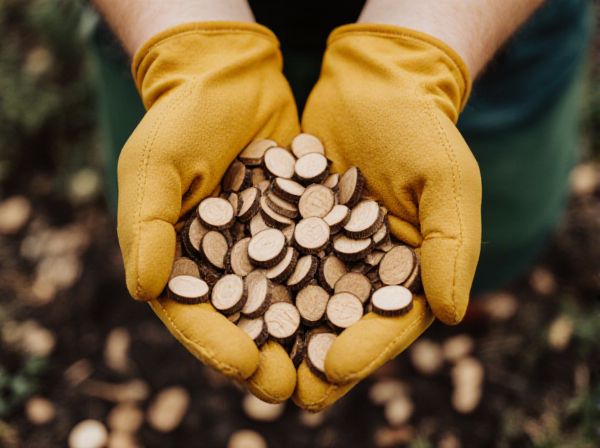
Wood chips vs Rubber mulch Illustration
Wood chips provide natural nutrients as they decompose, improving soil quality and supporting plant health, while rubber mulch offers superior durability and does not break down over time. Wood chips are biodegradable and environmentally friendly but may need more frequent replacement due to decomposition and weathering. Rubber mulch resists pests and fading but can retain heat and lacks organic benefits for soil enrichment.
Table of Comparison
| Feature | Wood Chips | Rubber Mulch |
|---|---|---|
| Material | Natural wood pieces, organic | Recycled rubber, synthetic |
| Durability | 1-2 years, decomposes over time | 5-10 years, long-lasting |
| Safety | Biodegradable, can harbor insects | Non-toxic, may cause odor |
| Cost | Low to moderate, affordable | Higher initial cost, cost-effective long-term |
| Maintenance | Requires periodic replenishing | Minimal maintenance, no replenishing needed |
| Environmental Impact | Eco-friendly, biodegradable | Recycles waste tire rubber, not biodegradable |
| Appearance | Natural look, blends with landscape | Variety of colors, consistent texture |
Introduction to Wood Chips and Rubber Mulch
Wood chips are organic mulch made from shredded tree bark and branches, offering natural nutrients and improving soil fertility as they decompose. Rubber mulch consists of recycled tires, providing long-lasting durability, excellent moisture retention, and resistance to pests without breaking down. Both mulches serve landscaping and playground safety purposes but differ significantly in environmental impact, maintenance, and cost.
Key Differences: Organic vs Synthetic Mulches
Wood chips are an organic mulch made from shredded tree bark and wood, offering natural decomposition that enriches soil with nutrients over time. Rubber mulch is a synthetic alternative composed of recycled tires, providing durable, long-lasting ground cover without breaking down or enhancing soil fertility. The key difference lies in wood chips improving soil health through organic matter, whereas rubber mulch focuses on durability and low maintenance without contributing to soil nutrition.
Longevity and Durability Comparison
Wood chips typically last 1 to 2 years before decomposing, requiring frequent replacement, while rubber mulch can maintain its structural integrity for over 10 years without significant wear. Rubber mulch resists fading, cracking, and weather damage better than organic wood chips, which are prone to mold, insect infestations, and breakdown under moisture exposure. This durability makes rubber mulch a cost-effective solution for long-term ground cover in landscaping and playgrounds.
Impact on Soil Health and Plant Growth
Wood chips improve soil health by breaking down and adding organic matter, enhancing microbial activity and nutrient availability for plants. Rubber mulch, made from synthetic materials, does not decompose, offering no organic benefits and potentially trapping heat that can stress plant roots. While both types suppress weeds and retain moisture, wood chips promote healthier plant growth through natural soil enrichment.
Weed and Pest Control Effectiveness
Wood chips provide natural weed suppression by blocking sunlight and gradually decomposing to enrich soil health, although they may harbor pests like termites if not maintained properly. Rubber mulch offers superior long-term weed control by creating a durable, non-organic barrier that prevents sunlight penetration and does not attract insects or pests. Both options require proper installation, but rubber mulch excels in minimizing pest issues while wood chips contribute to soil ecology.
Safety and Environmental Considerations
Wood chips offer a natural, biodegradable option that decomposes over time, enriching soil health and reducing landfill waste, while rubber mulch, made from recycled tires, poses potential chemical leaching risks and does not break down. Wood chips are generally safer for children and pets due to their non-toxic composition, whereas rubber mulch may cause overheating and emit volatile organic compounds under high temperatures. Environmental considerations favor wood chips for sustainability and ecosystem benefits, while rubber mulch prioritizes durability but requires careful management to mitigate environmental impact.
Aesthetic Appeal and Design Versatility
Wood chips provide a natural, organic appearance that blends seamlessly with garden landscapes, enhancing visual appeal with rich, earthy tones and textures. Rubber mulch offers a consistent, vibrant color palette that retains its hue over time and supports diverse design applications, including playgrounds and landscaped pathways. While wood chips decompose and evolve aesthetically, rubber mulch maintains uniformity and durability, making it ideal for long-lasting, customizable design projects.
Cost Analysis: Initial and Long-Term Expenses
Wood chips generally have lower initial costs, typically ranging from $20 to $60 per cubic yard, while rubber mulch costs between $50 and $120 per cubic yard. Over the long term, wood chips decompose and require annual replenishment, increasing maintenance expenses, whereas rubber mulch is more durable and can last up to 10 years without replacement, reducing long-term costs. Factoring in installation, frequent replacement of wood chips often leads to higher total expenses compared to the higher upfront investment but lower maintenance costs associated with rubber mulch.
Installation and Maintenance Requirements
Wood chips mulch requires moderate installation effort, typically laid to a depth of 2-4 inches and replenished annually to maintain appearance and effectiveness. Rubber mulch involves a more intensive installation process due to its heavier weight, needing a weed barrier underneath and occasional raking to keep the surface even, but it does not decompose or require frequent replacement. Maintenance for wood chips includes periodic topping up and potential pest control, while rubber mulch offers low maintenance with long-lasting durability and resistance to weathering.
Best Uses: Choosing the Right Mulch for Your Garden
Wood chips are ideal for natural garden beds, walkways, and around trees, providing organic material that decomposes to enrich soil health and support beneficial microorganisms. Rubber mulch excels in playgrounds, high-traffic areas, and erosion-prone slopes due to its durability, low maintenance, and excellent drainage properties. Selecting mulch depends on garden goals: wood chips improve soil fertility and moisture retention, while rubber mulch offers long-lasting protection and vibrant color stability.
Wood chips vs Rubber mulch Infographic

 gardendif.com
gardendif.com